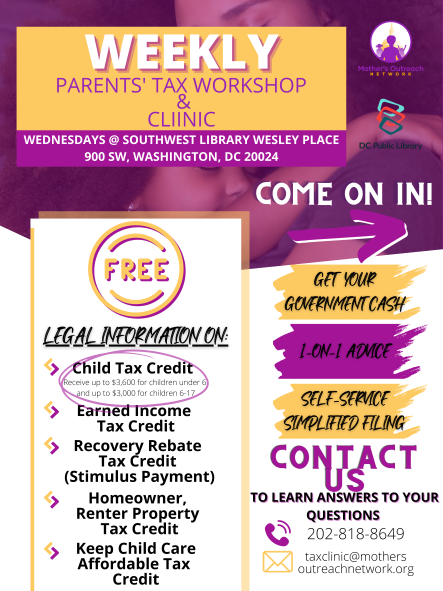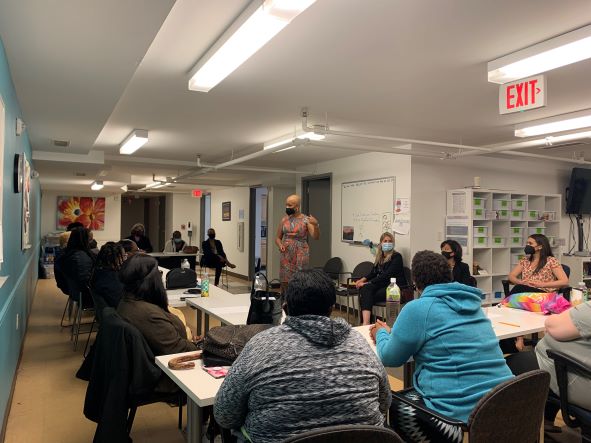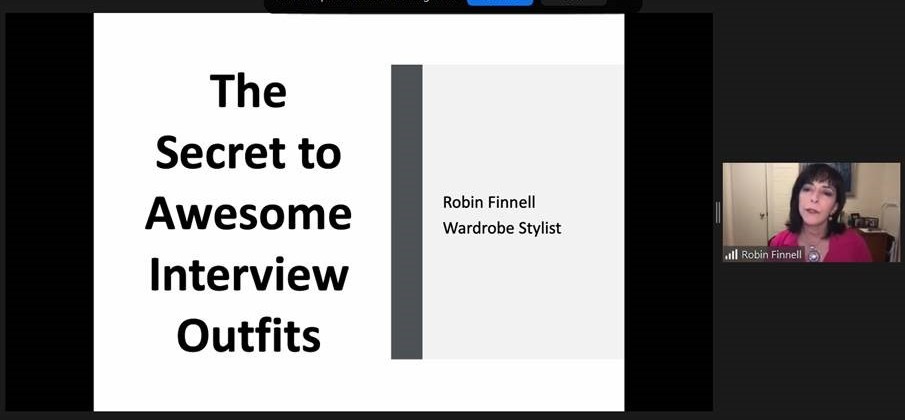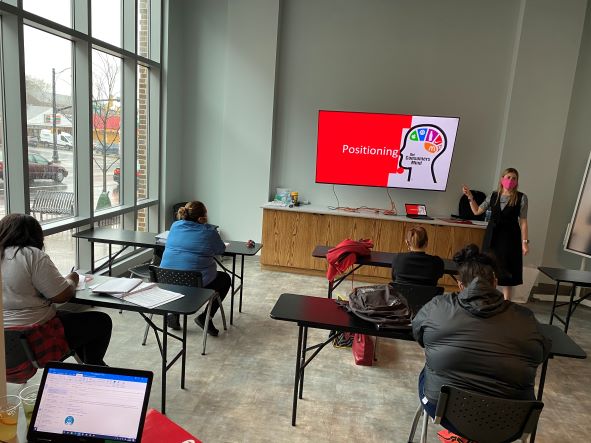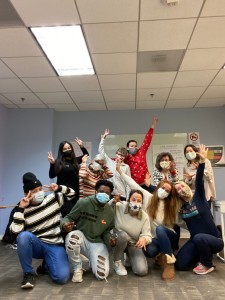The What, Why, & How for the DC Budget
Last month, the Catalogue for Philanthropy convened four of our nonprofit partners — the Washington Legal Clinic for the Homeless, Jews United for Justice, the Washington Area Bicyclist Association, and Black Swan Academy — to share about the advocacy work they do around the DC budget, why such advocacy is important for residents to engage in, and where people who are unfamiliar with the budget can get started. This virtual panel was moderated by David Meni, Acting Chief of Staff for Ward 1 Councilmember Brianne Nadeau, and illuminated much of the city budgeting process and how the budget concretely impacts our lives from year-to-year.
“You maybe only hear about the budget when it’s being formulated or when it’s before the Council,” David observed in his introduction to the event. “But budget season is basically year-round. There’s always something to do on it.“
Though the 2022-23 fiscal year budget was passed in June, not only does budget advocacy transition into other important advocacy as our partners demonstrated with the examples they gave, but the work of setting Councilmembers’ budget priorities also tends to start earlier than most people think. As David mentioned at the end of the panel, “getting your particular issue on a Councilmember’s priority list is something that can happen at any time or happen early and often.”
With this in mind, the Catalogue aims to summarize some of our biggest takeaways from the event about how to contextualize our city’s budget, why exactly advocacy is so important, what each of our nonprofit partners are advocating around and, finally, what you can start to pay attention to for next year’s budget.
Please note that panelist quotes have been edited and condensed for clarity. Visit this link to watch the full event.
Putting the Process into Perspective
“At the federal level, you see the President send down the budget and Congress rips it apart. It looks completely different by the end but it’s a much longer, much more resourced process,” Amber Harding, Director of Policy and Advocacy at the Washington Legal Clinic for the Homeless, explained. “In DC, the Mayor puts something out and the Council doesn’t have that much time to work on it. They don’t have the same kind of committee structures and staffing that Congress has to fix it. So, often, even though it’s supposed to be the Council’s budget, the Council has a real hard time (making) major changes to the Mayor’s budget.”
DC is a city where many residents are politically engaged on a national level. While this is important and necessary, we also believe that staying updated on local news and getting involved in local politics is crucial to both understanding the place where we live and making it a better place to live.
“Budget advocacy is extremely important for anyone who’s doing policy work or community work, knowing that the decisions that are made impact our day-to-day experiences, particularly when we’re talking about marginalized populations,” Samantha Davis, Founder and Executive Director of Black Swan Academy, noted. “The budget has a huge role to play in terms of what resources are trickling down to us.“
In addition to being a document that reflects the values of elected officials in its choices, the budget is also the biggest piece of legislation the City Council passes. “What’s the city focusing on? Is it spending more money on police or on affordable housing? Are developers getting giant tax breaks — the same developers who are contributing money to elected officials?” Amber asked. “It’s probably the most impactful thing the city does every year because the budget is a demonstration of the priorities of elected leaders… It’s insight into how the city is run and (whether) the people you vote for are doing what they said they’d do when you elected them.”
Though the budget process is complex and can be difficult to understand, our panelists helped to demystify some of the ways in which the DC government operates. For instance, if bills have a fiscal impact, even if they are passed and signed by the Mayor, they still need to be funded in the subsequent budget. “You can’t find the money within passing a bill,” David mentioned. “If you don’t get legislation funded within something like three years, it basically lapses and gets repealed.”
This makes advocating for changes within the budget even more critical, since funding a bill is the way to make sure it’s implemented. “When we’re talking about creating these new systems, addressing various disparities that we might be experiencing, we can’t have really effective policy and legislation without having the dollars to support it, and vice versa,” Samantha said. “Engaging in budget advocacy alone is also something that I critique often, because we can’t continue to pour money into failing systems, so it does work hand-in-hand.”
What Does a Victory Look Like?
One example of how budget advocacy transitions into year-round advocacy is in the Legal Clinic’s fight to end homelessness. “The budget is very clear — when you fund permanent housing vouchers for people who are homeless, you are ending that person’s homelessness permanently,” Amber emphasized.
This year, they ran a campaign to reform rapid rehousing, a time-limited housing program in the city that nearly everyone who goes into an emergency shelter is placed into. While the time limit was extended during the pandemic, the Mayor instructed the agency to start terminating families in the program once the public health emergency ended, resulting in hundreds of families who are going to be evicted because only 3% of them can afford rent when their subsidies are terminated. 97% of these families are Black and most are extremely low-income. Many of them end up being displaced entirely from the city because they can’t find places that they can afford to rent.
Through the budget, the Legal Clinic was able to get 400 slots of housing for families to transition from rapid rehousing into a permanent program. The Council also recently introduced permanent legislation to stop the time limits and make it a program that transitions people into housing that meets their needs instead of dropping them off a cliff. However, even if this legislation is passed, it must still be funded. “So, next year, when we’re talking about the budget, we’ll be talking about how the only way to end that cliff is to fund the bill,” Amber said. “We continue to do the work to solve the bigger problems.”
Similarly, Jews United for Justice advocates around the budget with a multi-year plan in mind. “The big goal is making childcare more affordable and possible, particularly for families with lower incomes,” Sarah Novick, DC Director at Jews United for Justice, shared. “We know that’s not going to be possible until we are making sure that early childhood educators are getting enough money to sustain their families and lives, (so that we can) create a childcare system that will be able to accept more children into it.
Jews United for Justice partners with the Under 3 DC campaign and works to implement the Birth-to-Three law, a robust and far-reaching law made up of many programs to support families with young children ages 0-3 around health supports, behavioral health supports, education, and childcare. “It’ll cost hundreds of millions of dollars when it’s fully funded,” Sarah continued, “and we’re inching our way there. Every year, our advocacy to get it funded is very important… Even the small asks are important.”
A big part of their advocacy work is rooted in organizing with coalitions. “We work together to craft what our yearly campaign goals are, what we think is possible to win from year-to-year, what an ambitious win would be, and (we) make those calculated decisions as we go along,” Sarah elaborated. For them, this advocacy looks like making asks of Councilmembers, getting Councilmembers and staff to work together to find the funds, mobilizing their base to make calls and testify at hearings — all of which help to ensure that elected officials know that many people are making these requests, which emphasizes how badly the requests are needed.
“We wanted full implementation of Birth-to-Three to happen within ten years,” Sarah said. “We’re a handful of years in and, unfortunately, it hasn’t been fully funded every year.”
Especially when it comes to programs that have a big price tag, like the Birth-to-Three law or the Vision Zero plan that the Washington Area Bicyclist Association is driving toward, finding funding sources to implement these programs on a smaller scale is often challenging, let alone funding them on the larger level of systemic change, which many residents know is needed.
“(We actually want) to phase out traffic fines because we want to fix the roads, we want to change the infrastructure,” Jeremiah Lowery, Advocacy Director at the Washington Area Bicyclist Association, stressed when elaborating on the omnibus bill they’re pushing that will move DC closer to achieving its Vision Zero goals around transportation safety. Though they didn’t get funding for this bill the year before, in this last budget cycle, they were able to secure a funding source — getting dollars from new traffic cameras to fund the bill, as well as moving future dollars into bike repair and bus projects.
“That’s significant because, oftentimes, money from these traffic cameras usually go to the general funds,” Jeremiah explained, “and they’re not actually going to sustainable solutions that lead to preventing traffic deaths. Now… funding from (traffic cameras) will be used to prevent traffic fatalities and deaths, and will be used to fix roads, which is the purpose.”
Part of the complexity around securing funding is, as Amber mentioned, because “the Council, as a whole, is not great in coming together and saying, “here are our top priorities as a Council.” One of the biggest flaws in the way that this city budgets lies in the committee structure, where Councilmembers serve on certain issue-area committees that can surface competing priorities, including ward-level priorities. “We try to be very careful. What do you tell human services to cut when you’re asking them to increase a program?” Amber asked. This is why coalitions can be powerful when engaging in advocacy. The Fair Budget Coalition, for example, which the Legal Clinic, Jews United for Justice, and the Washington Area Bicyclist Association are members of, “came together to say, “you can’t cut housing to fund healthcare.”
Black Swan Academy has also found some leverage within the current structure. “We do push Councilmembers and staff to talk to each other and to other committees, and (we) leverage that and say, this is the connection between police-free schools and mental health. Don’t you care about mental health?” Samantha explained. Analyzing members of each committee and what other committees these Councilmembers also sit on is an important aspect of their advocacy.
For Black Swan Academy, whose work is primarily guided by their Black Youth Agenda, a win can look like making sure the voices of young Black people are part of the conversation. When they supported larger efforts around the rapid rehousing crisis, which was one of the issues named by young folk on this year’s agenda, they signed onto letters, testified, and shared stories to show how young Black people in the community are impacted when families are terminated out of their housing after their rapid rehousing lapses.
On a multi-year level, Black Swan Academy has been fighting for police-free schools — removing armed police officers from school buildings and investing in resources and people who would create care-based, healthy, and equitable learning environments. In 2020, they were able to reduce a $23 million contract held by the Metropolitan Police Department (MPD) and move it to DC Public Schools (DCPS) so that instead of having MPD be in control of the training and hiring of security officers, it would be guided by people with backgrounds in education and who are working with school faculty. DCPS was also able to create a pilot initiative where schools should shift from hiring security officers to hiring restorative justice practitioners, additional mental health clinicians, and community members to do safe passage.
This year, however, the Mayor dedicated a lot of resources in her portion of the budget to cancel a planned phase-out of school police officers in the next five years, which the Council had previously passed. “We spent the past year organizing, again, to get the Committee (on the Judiciary and Public Safety) to say that we are actually committed to this phase-out and want to make sure the budget reflects it,” Samantha continued. The Council did vote again, recommitting to having fewer police officers in schools and investing in alternatives to policing in schools. “All the investments around school-based mental health, violence interruption, and safe passage (are) happening within the budget process.”
So, You Want to Advocate Around the Budget
“If it were easy, if everyone agreed, we wouldn’t have to do advocacy on it,” Amber said. “We’re doing advocacy because people aren’t automatically or naturally prioritizing the needs or wants of the groups we’re advocating for, and that’s why we’re down there.”
Having shared more context around the city budget, our panelists then gave some advice on getting started.
1. First, decide on the issue area(s) you’re most interested in to help narrow your focus.
When budget season rolls around, there are so many ways you can engage with it that the best place to start is by focusing on the issue area(s) you’re most interested in to avoid getting overwhelmed. “Look for those flashpoints,” Amber said. Because the budget is where the Council can step in to do some checks and balances, those flashpoints “are the places where you’re actually going to lift up where those conversations are happening, (and) where there are differences in opinion.”
From there, Jeremiah recommends building relationships with committee chairs for the areas you’re working on, which the Washington Area Bicyclist Association has found more success with. Samantha and Sarah also suggest attending both agency and budget oversight hearings.
“(The) agency oversight hearing process is useful for folks who are not connected to an organization as (they provide) an opportunity for anyone to come and talk about their own personal experiences with the agency,” Sarah mentioned. Doing so provides data for Councilmembers to later go back to the agency and ask follow-up questions, which will lead to conversations about how much money each of these agencies should have in the budget.
These hearings are then followed by budget oversight hearings, where directors of agencies present the budget, as well as give people time to testify and the Council to ask questions. “Most of the agencies have their own hearings or forums that are open to folks,” Samantha said, “and I’ve found those to be more helpful.”
2. Do your research outside of the Mayor’s resources.
Though the Mayor’s budget forum is often advertised, David explained that “it might be a good way of understanding the different components of the DC government, but not a great way of understanding what’s actually in the budget.”
Similarly, Amber recommended approaching the Mayor’s Powerpoint with care. “It’s often high-level, but sometimes pretty misleading,” she chimed in. “There’s federal money in there that was pre-existing or other things that don’t have anything to do with what she devoted this year (with) very little context.”
Sarah and Jeremiah advised signing up for the DC Council website’s newsletter, as well as individual Councilmember newsletters, especially for members who are chairing committees on the issue area(s) you care about. Staying updated on local news, such as through the Washington City Paper’s daily news digest, is also helpful.
The DC Fiscal Policy Institute shares a trove of resources about the budget, such as ‘A Resident’s Guide to the DC Budget‘ and their recent reflection on ‘What’s In the Fiscal Year 2023 Budget?‘ Be on the lookout, too, for events like budget briefings with agencies or agency heads that the community can attend and ask questions at.
Another great resource is to follow the organizations or coalitions doing advocacy in the issue area(s) you care about, such as these four nonprofit partners who spoke on our panel or the 400+ other local nonprofits in our network.
3. Don’t be afraid to talk to Council staff.
“You don’t need to go directly to members, especially around budget time,” David suggested. “Staff in the committees are the ones keeping track of moment-to-moment changes, (so) don’t be intimidated about talking to staff.”
Ask questions of the staffers on the committees relevant to your issue area(s). Most importantly, make sure that your ask is stated in more than one Councilmember’s priorities.
4. Sharing your story is important.
A common misperception around budget advocacy is that it is necessary to understand all the jargon and details in the budget. While being familiar with them can be helpful, as David shared, “it’s more about tone-setting.” When testifying — as all of our panelists have organized significant groups of people to do — people will show up and speak to the same theme about why they think ‘x’ is an important priority and why the Council should pull money from ‘y’ to fund this. “(Say) things in simple terms and put the onus on the committee to see how important that is,” David continued, “and then paid advocates and experts can follow up on the details of that work.”
In this vein, remember that you don’t have to be an expert! As Samantha added in the chat during the event, “We are not experts on the budget and that is okay. You don’t have to be and many are not.” Echoing this, Amber said, “I’ve been doing this work for 20 years and I still… have to ask a bunch of people, is this actually what this means?” Given that the budget is not a transparent document, it is absolutely okay to ask those follow-up questions.
Our Partners
The Washington Legal Clinic for the Homeless uses the law to bring justice to low-income, homeless, and people experiencing poverty in DC through direct legal services, community education, and policy and advocacy around housing, homelessness, and civil rights. You can learn more about their budget work this year through this article.
Jews United for Justice educates and mobilizes local Jewish communities and allies to take action on issue campaigns that pursue and promote social, racial, and economic justice. You can read their reflections on this year’s budget campaign at this article and learn more about their work in Montgomery County, Baltimore, and statewide in Maryland.
The Washington Area Bicyclist Association provides youth and adult education and conducts advocacy to expand the region’s trail network with the Capital Trails Coalition, complete a protective bike network around the region, prevent traffic deaths and fatalities through Vision Zero, as well as expand access to buses and multi-modal transportation options in areas that don’t usually have access.
Black Swan Academy supports Black youth in middle and high school in being social catalysts in their communities and creating the change that they know is needed. They meet the immediate needs of young folks through capacity-building and mutual aid, and organize through the Black Youth Agenda for police-free schools, and more mental health support, among other youth-driven issues.

